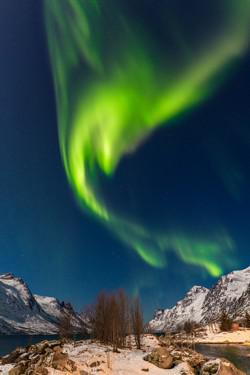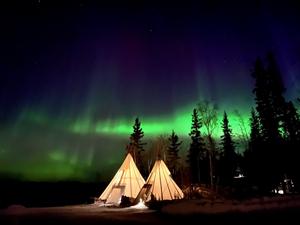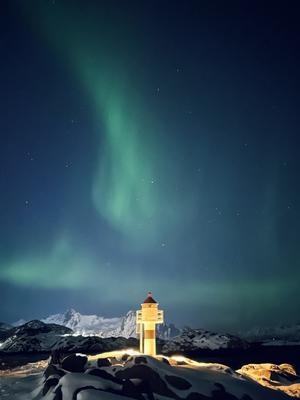Glossary term: Aurora
Description: An aurora is a display of diffuse variable-color light in Earth's atmosphere, mainly in the polar regions. In the north it is known as the Northern Lights or aurora borealis, in the south, Southern Lights or aurora australis. The aurorae vary in color from greenish-white to red, mainly occur at altitudes of about 100 kilometers, and form around two irregular auroral ovals centered on Earth's magnetic poles. They occur when charged particles from the solar wind or coronal mass ejections (CMEs) are trapped in Earth's magnetosphere, concentrated by magnetic fields in the upper atmosphere, and spiral along Earth's magnetic field lines toward the poles. Their interactions with atmospheric atoms and molecules produce the auroral emissions. This effect is enhanced during times of high solar activity. Aurora have also been observed on other planets in the Solar System notably on Jupiter and Saturn.
Related Terms:
See this term in other languages
Term and definition status: This term and its definition have been approved by a research astronomer and a teacher
The OAE Multilingual Glossary is a project of the IAU Office of Astronomy for Education (OAE) in collaboration with the IAU Office of Astronomy Outreach (OAO). The terms and definitions were chosen, written and reviewed by a collective effort from the OAE, the OAE Centers and Nodes, the OAE National Astronomy Education Coordinators (NAECs) and other volunteers. You can find a full list of credits here. All glossary terms and their definitions are released under a Creative Commons CC BY-4.0 license and should be credited to "IAU OAE".
Related Media
Till the End of the World, by Hang Li, China
Credit: Hang Li/IAU OAE
License: CC-BY-4.0 Creative Commons Attribution 4.0 International (CC BY 4.0) icons
Under the Stars with Steve, by Sheila Wiwchar, Canada
Credit: Wiwchar, Sheila; IAU OAE
License: CC-BY-4.0 Creative Commons Attribution 4.0 International (CC BY 4.0) icons
Icelandic Rivers of Light, by Sergio Díaz Ruiz, Spain
Credit: Sergio Díaz Ruiz/IAU OAE
License: CC-BY-4.0 Creative Commons Attribution 4.0 International (CC BY 4.0) icons
Multicolored aurora in Iceland, by Marco Migliardi on behalf of Associazione Astronomica Cortina, Italy
Credit: Marco Migliardi on behalf of Associazione Astronomica Cortina/IAU OAE.
License: CC-BY-4.0 Creative Commons Attribution 4.0 International (CC BY 4.0) icons
Northern light dragon over Ersfjordbotn/Norway
Credit: Rainer Sparenberg/IAU OAE
License: CC-BY-4.0 Creative Commons Attribution 4.0 International (CC BY 4.0) icons
Iceland aurora, by Emanuele Balboni, Italy
Credit: Emanuele Balboni/IAU OAE
License: CC-BY-4.0 Creative Commons Attribution 4.0 International (CC BY 4.0) icons
Northern Lights - Teepees
Credit: Oanh Vuong/IAU OAE (CC BY 4.0)
License: CC-BY-4.0 Creative Commons Attribution 4.0 International (CC BY 4.0) icons
The Big Dipper in the Polar Night
Credit: Stephanie Ziyi Ye/IAU OAE (CC BY 4.0)
License: CC-BY-4.0 Creative Commons Attribution 4.0 International (CC BY 4.0) icons
Fire of the Sky
Credit: Stephanie Ziyi Ye/IAU OAE (CC BY 4.0)
License: CC-BY-4.0 Creative Commons Attribution 4.0 International (CC BY 4.0) icons
Northern Lights Color
Credit: Jason Johnson/IAU OAE (CC BY 4.0)
License: CC-BY-4.0 Creative Commons Attribution 4.0 International (CC BY 4.0) icons


















